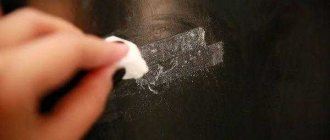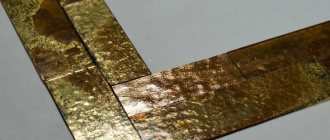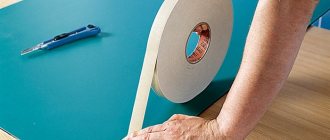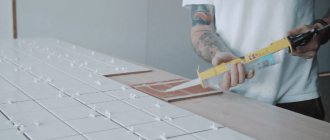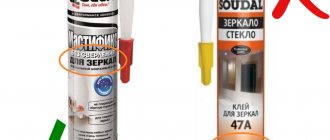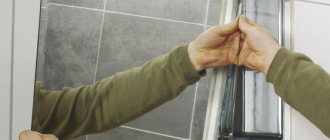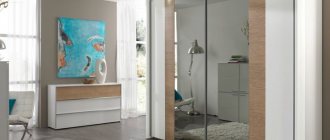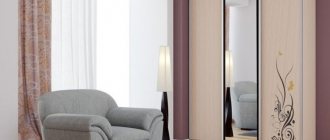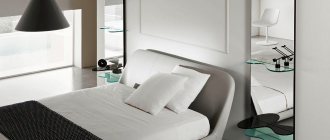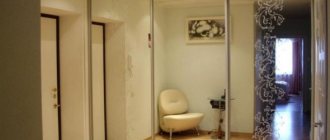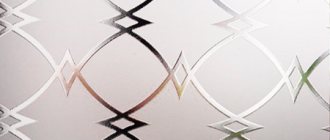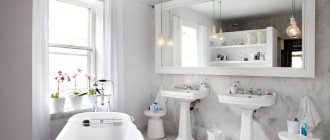A mirror is a fragile product that requires some care. This item is an integral part of every home and apartment. Situations often arise when it is necessary to fix glass on a smooth surface. There are a number of nuances here that a person should be aware of. It is also worth choosing the right substance that will give a reliable connection. Therefore, the editors of the YaNashla website have prepared for you a rating of the best glue for mirrors for 2022.
Adhesives and adhesives for mirrors
To glue a mirror, you need to select reliable and proven adhesives that can primarily withstand the product’s own weight. It is also worth considering temperature changes and humidity. Mirrors are a functional and aesthetic decorative element. Therefore, they are present in any home with rare exceptions.
When buying a mirror surface, the master is faced with the question of mounting it on the wall, furniture or door. There are several mounting options. Construction stores offer the buyer a wide range of adhesive mixtures for work. However, it makes sense to talk about the most popular ones.
There is no need to be afraid of such a method as gluing; in many cases this is the best choice for many reasons.
Soudal glue
Soudal mirror adhesive is one of the popular adhesives that can withstand prolonged exposure to moisture. It is made on the basis of synthetic rubber. Used for decorative finishing of mirror surfaces in rooms with high humidity: bathrooms, kitchens, swimming pools.
Advantages of Soudal glue:
- Resistant to moisture.
- High adhesion to most surfaces.
Before gluing the mirror to the wall in the bathroom, you need to read the instructions on the packaging of the product. When installing, keep in mind that this adhesive contains a solvent.
Tytan glue
You can glue a mirror in the bathroom using Tytan glue. This is a specialized adhesive composition, which is a mixture of rubber and synthetic resins.
Advantages:
- Possibility of gluing glass plates to surfaces made of different materials. It can be concrete, metal, ceramic tiles, wood, drywall.
- High strength index.
- Elastic seam, adhesive mass fills all voids.
- Resistance to prolonged exposure to moisture.
Before applying Titan glue, it is necessary to degrease the working area. The easiest way to apply it is with a special gun.
Loclite glue
To glue the mirror to the tile, you can use two-component Loclite adhesive. It is a mixture of acrylic ester and activator. This American brand is considered effective and reliable in the market among its competitors. When using it, you need to connect the components with identical parts. Apply evenly to the surfaces to be bonded.
Tile adhesive
You can try gluing the mirror in the bathroom using tile adhesive. This method is considered unusual, even original. When choosing a dry mixture, it is important to read the recommendations indicated on the packaging. If it does not indicate that the glue is not suitable for gluing mirrors, then it can be used.
To make the connection reliable, it is necessary to perform work according to a certain scheme. The decorative layer may need to be removed.
There are step-by-step instructions for this:
- Preliminarily mark the place where the mirror plate will be located.
- Remove the old tile, being careful not to destroy the surface underneath.
- Clear the wall. Knock off the old mortar.
- Prime the surfaces.
- Attach a horizontal bar to the bottom of the marked outline. Install a metal border on top of it.
- Attach another horizontal bar to the top.
- Install side curbs.
- Mix the dry mixture with water using a mixer. Apply tile adhesive to the free area of the wall with a spatula in an even layer.
- Slowly glue the bottom edge of the mirror plate to the glue. Place plastic crosses around the edges.
- Gently press the glass onto all surfaces.
Press the plate with your palms for 15-20 minutes so that the glue has time to set. Ultimately, wait for the tile adhesive to dry completely. The time period is indicated on the packaging. Remove the crosses and rub the seams.
Mounting double-sided tape
You can glue the mirror to different surfaces using mounting tape. With its help, you can fix the mirror plate on the wall without affecting the facing material.
It is a double-sided adhesive tape that needs to be secured to the back of the mirror plate. Next, you need to lift it to the required distance from the floor, set it level, lean it against the wall, press it with your palms, and hold it there for 5 minutes. It is necessary to clean the working surface from dust in advance and degrease it with alcohol.
Mounting tape is not suitable for large reflective panels. It won't support their weight.
Special compounds and liquid nails
If you have no experience in such a matter as attaching a mirror to a wall, then a hardware store can recommend liquid nails. This is another option that is safe for facing materials and provides reliable fastening. It is a special glue that firmly holds any objects together on vertical planes.
Installation:
- Using liquid nails, stick the metal profile to the wall along the contour of the glass.
- Fix plasterboard with increased water resistance on top of the profiles.
- Attach the mirror object to the prepared surface with liquid nails. It is enough to apply the adhesive mass along the contour in dots.
Liquid nails can withstand greater loads than mounting tape.
Basic requirements for glue
When choosing a composition that meets all the requirements, even from the most famous manufacturer, you must carefully ensure that the product is intended not just for ordinary glass, but specifically for mirrors.
In fact, some of the substances may contain ingredients and additives that can destroy the amalgam (reflective back layer), which will subsequently lead to stains on the mirror product. The gluing solution should not contain various acids and alkalis.
IMPORTANT! It is not recommended to use universal products, which can also harm the amalgam. The fact is that many manufacturing companies, in an effort to reduce the price, add chemical components to the composition that harm the reflective base.
Also, when selecting, the components used in preparing the glue and the characteristics of the room where the art will live are very important.
Since significant changes in temperature can cause glass sizes to change, so for bathrooms it is better to use products that can withstand high humidity and be resistant to cold and warm air. If the elasticity is weak, after drying, a hard substrate forms on the base, which is why the material may crack.
Required characteristics for the product:
- absence of toxins, acids and alkalis in the substance;
- formation of a high-quality seam that is resistant to moisture;
- ease of use and ease of application;
- high reliable strength;
- high percentage of adhesion;
- fast hardening;
- colorlessness;
- elasticity;
- availability.
REMEMBER! Using a product with a poor quality composition may lead to negative results. At best, dull stains will form that spoil the appearance; at worst, the product may be destroyed.
Mechanical fastening method
If the master could not find something to glue the mirror to the wall, he can use hardware. To do this, you need to select fasteners depending on the weight of the glass plate. This type of installation is suitable for fixing large mirrors.
Procedure:
- Make holes in the wall using a hammer drill or drill, depending on the surface material.
- Hammer in the dowels.
- The screws on both sides must be equipped with rubber gaskets so as not to damage the mirror surface. Screw them through the prepared holes.
If the glass does not have mounting holes, you can make them yourself.
To do this, you need to perform a number of actions:
- Use a sharp object to mark the centers for future holes.
- Using a diamond drill, start drilling. Allow the drill to cool frequently to prevent the glass from breaking.
- Using fine sandpaper, sand the edges of the holes.
It is important to perform all movements carefully, without pressure, so as not to damage the integrity of the plate.
How to glue a mirror on a mirror
Sometimes situations arise when you need to connect two mirror surfaces to each other. This is an unusual gluing method that requires the purchase of special glue for mirrors. You can glue mirrors with their edges to increase the size of the reflective surface or glue them with their surfaces facing each other. The first option is acceptable for connecting small glasses, since fastening the edges is considered less reliable.
How to glue a mirror to a wall
Once it has become known whether it is possible to glue the mirror to the wall, it is necessary to begin work.
To do this, there is the following step-by-step instructions:
- Prepare the surface for gluing. Clean from debris, degrease with medical alcohol or gasoline.
- Transfer the dimensions of the mirror to the wall. It is necessary to mark the dimensions with a marker so that you can see where to lean the plate.
- Apply glue to the back side of the mirror surface in dots along the contour. There should be approximately 2-3 cm of allowance left from the edges. Form a grid of glue on the central part of the product.
- Attach borders made of metal profiles along the edges of the frame marked on the wall.
- Install tiled crosses between the borders and the glass plate. Additionally, you can apply mirror glue to the wall.
- Carefully lean the mirror against the wall starting from the bottom mark. The movements must be carried out smoothly and the pressure must be controlled.
- The technician will have about 5 minutes to adjust the glass surface. After this, the glue will harden.
After the main adhesive mass has hardened, the borders are removed and the crosses are removed. The seams along the contour are filled with silicone or acrylic sealant.
For wallpaper
When gluing a mirror product to a wall with wallpaper, some problems may arise. If you lean the reflective plate against it over its entire area, it may not be in tight contact with the wall. Because of this, the integrity of the connection will be compromised, and the glue will not be able to firmly connect the materials. One option for creating a strong bond is to prepare the base.
Step-by-step instruction:
- From a sheet of DPV, cut out a rectangle with dimensions not exceeding the reflective surface. This can be done using a hand saw or jigsaw.
- To fix the fiberboard on the wall, you need to mark the places for fastening elements on it and accurately transfer them to the wall. Drill holes in the wall using a hammer drill or a drill in the fiberboard.
- Using dowels and screws, secure the sheet material made of wood fibers to the wall, while recessing the caps.
- Apply glue to the wood along the contour, departing 2 cm from the edges.
- Slowly place the glass piece against the prepared base. Hold for about 15 minutes with your palms, pressing lightly.
The heavier the mirror weighs, the more glue and fastenings for the fiberboard will be needed.
Concrete wall
You can attach a reflective surface to a concrete wall using tile mortar or special glue. Step-by-step instructions have been provided above. It is important to prime the concrete surface in advance to increase the quality of adhesion. A good solution is acrylic primer. It is better not to soak it with universal concrete contact; the adhesive composition may not withstand the weight of the mirror and peel off.
For paint
To attach a mirror to a painted surface using special glue, preparation is necessary. It consists of removing the decorative layer, cleaning and degreasing the working surface. Priming with a deep penetration compound is necessary, or a primer with increased adhesive characteristics is recommended.
Types of materials
In the chemical industry you can find a number of different types of glue. Today, with the help of such products, there is an opportunity that allows a whole range of finishing materials to be attached without the use of nails, screws, and so on.
When fixing mirrors in this way, experts distinguish three types of different bases, for example :
- solvent-based;
- silicone-based composition;
- hybrid options.
Solvent based products
The option of using solvent-based glue is an economical case, where the product itself will be as cheap as possible. Such brands may write on their packaging that the product is intended for use with glass.
But, it is important to distinguish between the concepts of glass and mirrors . Quite often, manufacturers introduce a component into solvent adhesive that contains aggressive components. They, in turn, destroy the amalgam layer on the product. Such destruction of the mirror is a matter of time.
It is worth noting that damage becomes noticeable only after a certain point in time.
Silicone compounds
If the glue is made on the basis of silicone, then its chemical composition is neutral. Thus, if the contact is incorrect, there cannot be any side effects.
This glue is very practical for mirrors, because it helps to firmly connect the mirror to the wall. You should know that silicone products always take a little longer to dry than the previous option. Undoubtedly, the better the material, the greater its amount .
Hybrid options
Construction experts note the fact that working with hybrid-type compositions is undoubtedly easier. This is especially true for those people who do not have specific experience in construction and finishing work. It is important to understand that the cost of such material is even more expensive, but also of even better quality.
How to glue a mirror in the bathroom
Knowing what kind of glue to use to glue the mirror on the walls, you need to talk about the features of working in the bathroom. Constant exposure to moisture and changing temperatures entails rapid destruction of adhesive joints. The adhesive mass must be resistant to humidity and not afraid of temperature changes.
On tiles
Mirrors in the bathroom are somewhat more difficult to glue than in other rooms. This is due to the classic covering of most bathrooms - tiles. Features are associated with the last stage of the work - filling the seams with sealant.
Step-by-step instruction:
- Apply glue to the back side of the reflective plate. Leave about 2 centimeters from the edge. Fill the center with a lattice of adhesive mass.
- Place the mirror against the wall, starting from the bottom.
- Make a support in advance so that the product remains suspended without falling.
When the glue dries, you need to seal the seams with sealant. Acrylic is used for this.
What are the advantages of do-it-yourself mirror restoration?
There are several simple ways that anyone can do.
Not everyone immediately decides to restore a mirror with their own hands. This most often occurs due to ignorance of all the advantages of this process. But independent mirror restoration has a lot of positive aspects that can encourage you to carry it out. These include such aspects as:
- In small towns, or even villages, you can rarely find a master who can properly repair a mirror. Not everyone can restore amalgam. Decorating small flaws yourself is much easier than looking for a specialist restorer of this profile.
- Repairing damage to a cracked mirror is not a cheap pleasure. Most often, such a procedure will cost more than buying 3 new mirrors. And decorating with your own hands involves spending only on a minimum set, which often consists of one stencil.
- If a crack on a wooden surface can be easily covered with wax and this does not require special skills, then restoring glass is a completely different matter. Therefore, again, it is much easier to repair the crack with an interesting pattern that would match the interior. This definitely doesn’t require any special skills or knowledge, just paint and desire.
- It's no secret that a small scratch can turn into a big chip. This most often happens due to the transportation of the mirror to the workshop. And when the piece of furniture has already been delivered, it turns out that it cannot be restored. It is for this reason that it is better to leave the structure in its original place and take advantage of interesting ideas for independent restoration.
Even a slight blow is enough for a crack to appear on the surface of the mirror.
How to glue a mirror to a closet
One of the most popular questions that owners of apartments and private houses ask during renovations is how to glue a mirror to a cabinet door. Initially, you need to think about what will be used for gluing. Having decided what to use to glue the mirror to the cabinet, you can begin further work.
Experienced craftsmen recommend using mounting tape to avoid damaging the front surface of the furniture. In this case, the tape is easier to remove later, although it will be a hassle. If glue is used, traces will remain if you want to dismantle it.
Step-by-step instruction:
- Mark the dimensions of the glass on the cabinet door. A black marker is suitable for this. You can remove the door from its hinges in advance to make it easier to work with. Wipe the surface with a cloth moistened with medical alcohol.
- Cut several small strips of tape and place them along the contour of the mirror plate, at a distance of about 30 cm from each other.
- Additionally, apply mirror glue to its back.
- Remove the protective layer from the mounting tape and lean the glass against the prepared cabinet door.
Quickly adjust the position of the mirror product using the marks. Knowing how to attach a mirror to a closet, you can decorate the interior and make the furniture more varied and functional.
Rating of adhesives for mirrors
When choosing which glue to glue the mirror with, they are guided by the special packaging markings. You cannot take a standard one, even one intended for repair or construction. It is created specifically for fragile products in order to ensure maximum adhesion to the wall and prevent corrosion of materials, the appearance of an uneven seam or the rapid fall of an element.
The VyborExpert.ru team evaluated the range from different manufacturers to choose the best. The rating includes products that received high ratings from experts and users based on the following characteristics:
- List of components;
- Water resistance;
- Frost resistance;
- Full fixation time;
- Smell (pungent, mild);
- Clutch reliability.
Feedback from users, craftsmen and experts was taken into account, which made it possible to select the TOP 8 from a large list.
To metal
Before gluing the mirror to the metal, you will have to make the right choice of adhesive from several types.
The most effective include:
- High temperature silicone. Withstands sudden changes in temperature (not only above zero), prolonged exposure to oils and washing liquids.
- Moment Crystal. An effective adhesive that returns to its original state after deformation.
- Epoxy adhesive. Two-component substances that are used to combine different or one property of materials. By mixing the two components, you can get an adhesive mass that hardens under the influence of room temperature.
- After choosing an adhesive, you can begin gluing the mirror onto a metal surface.
Step-by-step instruction:
- Degrease the metal using a solvent or medical alcohol, clean it from dirt, rust, and plaque.
- Clean decorative coatings with a grinder or grinder.
- Apply glue to the back of the reflective plate.
- Heat the glass evenly with a hair dryer to 30 degrees. It is important to slowly increase the temperature so that the mirror surface does not crack.
- Place the plate on a metal surface and hold for 5-10 minutes.
For reliability, you should pay attention to pre-treatment with epoxy primer. It will protect the metal from corrosion and provide better adhesion.
Thanks to additional heating, a more reliable connection and faster setting are obtained. The entire technology for working with cold welding can be read here.
What is the best glue for mirrors?
The Top 8 team of VyborExpert.Ru reduces the list of products to a minimum. We will help you quickly determine which product to prefer when working with mirror surfaces. To do this, we name the strongest aspects of each product from a huge list of offers from foreign and domestic manufacturers:
- Point 93 – economical, colorless, odorless composition, dispenser, low price, fastening to any surface;
- Tytan – low price, high quality, strong hold, economical consumption, convenient tube with dispenser;
- Master Klein 3554370 – transparent hypoallergenic composition, odorless, strong fixation, fastening to any surface, leaves no marks, sets quickly;
- 1 New MA-010 – instant effect, compact tube, dispenser for application, gentle composition for fixing any surfaces.
- Astrohim AC – 9100 – strong adhesion, practical packaging, minimal volume, dispenser, versatility.
A detailed analysis of the strengths of the rating from a team of experts will allow you to choose “liquid nails” for attaching mirrors and other materials. The list includes both professional construction compounds and proposals used for everyday needs and quick fixation of small automotive parts.
On laminated chipboard or chipboard
To stick a mirror on laminated chipboard or chipboard, you can use mounting tape or liquid nails. The principle of operation is the same as with other surfaces. It is better to leave the glued structure overnight under a light load to create a stronger connection.
When it became clear how to glue a mirror to a cabinet, tile, metal, wood, concrete, or to walls with wallpaper, it was easy to carry out repair work yourself and decorate the interior. Pay enough attention to the choice of glue and follow the detailed instructions. You can't skimp on fasteners when it comes to large mirror plates.
What you need to know about glue?
Undoubtedly, professionals will say that one should not deviate from the banality, and it is necessary to purchase glue that has the inscription “for mirrors” . There is also universal glue, but in this case it is definitely not helpful, since not only will it not attach the product properly, but it will also slightly spoil the appearance of any mirror.
It should also be noted that a large number of people are trying to reduce the cost of goods, and this is done by reducing the quality of certain components.
Thus, when purchasing, you must be guided by some quality criteria :
- Everything that is included in the product must be carefully studied. The main thing to know is that among all the components you should not see an alkali or any acid.
- Under no circumstances should the glue harm the mirror coating.
- Glasses must have a certain pH level.
- If the composition contains substances that are cheap, their quality and smell will be harmful to your health.
- The glue should be as suitable as possible and firmly connect the mirror to the base of the wall.
- In any case, the color of the glue should be transparent or white.
Option 4 – using double-sided tape
If the mirror is light and thin enough, you can use moisture-resistant double-sided tape to install it; in this case, we install it like this:
- We mark horizontal and vertical guide lines on the wall using a level.
- Degrease and dry the surface of the tile and the back side of the mirror sheet.
- Place double-sided tape on the back of the sheet in stripes.
- Moisture-resistant silicone sealant can be applied between the strips of tape for more reliable fixation.
- We remove the protective film from the tape and carefully, focusing on the control lines, fix the mirror on the wall.
Using double-sided tape, installation must be carried out carefully, because it will be difficult to fix something.
Preparation for work
After peeling off the mirror, traces of old glue may remain on the surface. They need to be wiped off with automotive solvent or other suitable substance, or carefully cut off with a razor. Next, as preparation, the gluing area is carefully rubbed with fine sandpaper to make it rougher. It is enough to achieve some clouding of the base, and the level of adhesion will significantly improve.
Also, the base should be cleaned of any dirt, dried, and then marked with a pencil in order to avoid mistakes during work. Most often, this place is located exactly in the center of the windshield. If the fallen bracket has torn out the top layer of glass, the mirror will have to be attached slightly to the side. Immediately before work, the glass and the base of the mirror should be treated with acetone, and then wiped dry with a clean cloth.
Choosing for the bathroom
- The most appropriate choice of adhesive for connecting a mirror to a particular surface in conditions of high humidity is Penosil Premium Mirrorfix adhesive-sealant. This tool is already as close as possible to professional ones.
In addition, it contains synthetic rubber. An important criterion when using the product is that the mirror should not be more than 6 millimeters thick. Experts note that the product is excellent for use in creating mosaics. The total time for the glue to dry is 15 minutes.The advantages of this glue are as follows:
- The glue perfectly resists moisture when open, as well as moisture in the form of vapor. The adhesive has no ability to deteriorate in case of constant exposure to humidity.
When the glue completely hardens, it becomes extremely strong, and most importantly, hard.
- The glue cannot deform when exposed to sunlight.
- The same products that work exclusively with wet environments include an adhesive called SOUDAL 47A.
This component also includes synthetic rubber. In addition to the standard attachment of mirrors, it can be used to create beautiful mosaics. The glue perfectly adheres to components such as ceramics, foam, and so on. The main advantage of the product is that it is not permeable to water, and at the same time it adheres to various materials. It is worth noting that this glue also contains a certain solvent.
At what altitude
Before you hang the bathroom mirror on the tiles, you need to decide on the height for it. It should ensure convenient but safe use of the reflective element for all family members. The optimal installation height is determined as follows:
- If there are children in the family, the lower edge of the canvas should be at a height of 1.2 m from the already tiled floor. This will allow children over 5 years of age to use it, and younger family members will not be able to damage it. If there are no children in the house, the installation height is chosen based on the height of the shortest family member. In this case, the lower edge of the product is placed 2 cm below the solar plexus point or at least not higher than the chest of this person.
- To ensure that the canvas is less covered by splashes of water and soap, the mirror is installed at a height of 20-40 cm from the edge of the sink.
- The height size of the mirror plate is chosen based on the height of the tallest family member so that the upper edge of the accessory is located 2 cm above the person. Additionally, the height of the doorway is taken into account. It is believed that the product should not be higher than the top edge of the door jamb.
Option 2 – for liquid nails
You can attach the mirror using liquid nails. Thus, it is installed in niches if there is a plasterboard gasket between the wall and the mirror or on a tiled surface. The product must be moisture resistant and not destroy the amalgam.
Before applying the product, the surface is thoroughly degreased, and control marks are made on the wall - landmarks. It is best to completely circle the mirror. Then an adhesive substance is applied to its back side.
Liquid nails are applied along the perimeter, retreating 2-3 cm from the edge and pointwise or in a grid - in the middle. After this, the sheet is lightly pressed against the wall, torn off for 1 minute and pressed again. The composition will dry within 24 hours. During this time, it is better to fix the mirror with a support.
Why the fastening may be broken
In modern cars, the rear view mirror is most often attached to the windshield. If you handle it incorrectly, it can easily break off. If the windshield is damaged, it is often necessary to replace it, which also requires removing the rear view mirror. In these two cases, the gluing procedure will help to install it back.
The mirror may also fall off for the following reasons:
- when cleaning the cabin, when a person hits it with his head;
- opening the right door while sitting in the cabin;
- a large passenger who sits in the front;
- incorrect previous installation;
- discrepancy between the thermal expansion and plasticity of the adhesive layer.
Possible problems when gluing car mirrors
Often, when independently installing a torn mirror, a car enthusiast is faced with a number of troubles, which it is better to know about in advance.
Poor quality glue
A low-quality composition has poor adhesion to smooth substrates, and therefore is not able to hold them in the desired position for a long time. In addition, second-grade adhesives quickly crack under stress and vibration, as a result of which the mirror can fall off while driving.
Cold surfaces
If the work is carried out in winter, it is worth warming up the parts to be glued in advance, for example, using a regular hair dryer. This technique will help increase the adhesion of materials and extend the service life of the seam.
Violation of technology
If the work is done incorrectly, the mirror will not be attached to the glass securely enough. Most often, beginners ignore degreasing the base, sanding it with sandpaper, and completely removing the old adhesive. All these violations entail a decrease in the quality of the adhesive joint.
Start of use too quickly
Before using the machine, you need to wait the time specified by the glue manufacturer before its final polymerization. If the seam is subjected to vibration and stress at an earlier time, the mirror may become detached.
